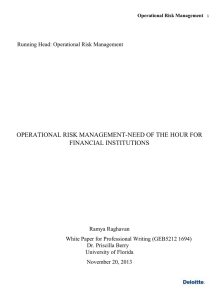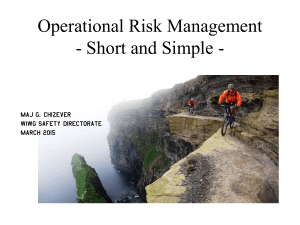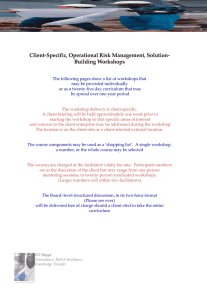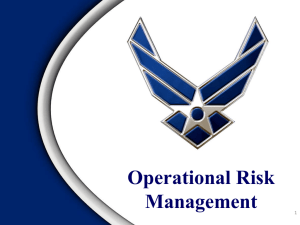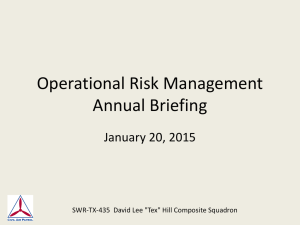Operational Risk Management: A Competitive Advantage
advertisement
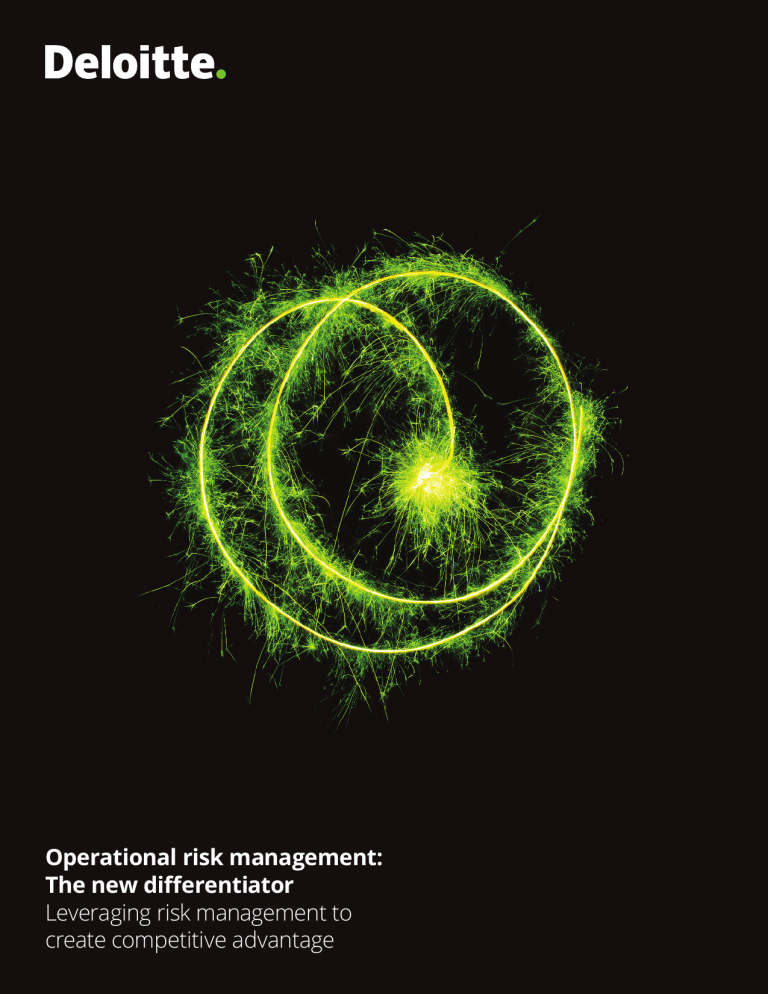
Operational risk management: The new differentiator Leveraging risk management to create competitive advantage Operational risk is embedded into the fabric of every organization. Are you leveraging operational risk management as an organizational imperative? Effective management of operational risks will increase C-suite visibility to material and emerging losses across your front line operations, while encouraging more informed risk taking. Integrating operational risk management strategy, processes and tools into your organizational goals will lead to improved product performance, greater brand recognition, and assist in delivering sustainable financial results. After all, well-informed executives leverage risk management to drive competitive advantage. We hope you will find this information useful as a reference point to better understand where your operational risk efforts land; what strategies might be most pertinent to you and your organization; and how applying those strategies can help you lead in your industry, navigate risks and opportunities, and disrupt the status quo. 2 The risk of doing business Organizations in industries face operational risk wherever they turn. To the left lie everpresent risks from employee conduct, third parties, data, business processes, and controls. To the right are inherent cultural, moral, and ethical risks. Layered on top are technology risks—which are compounded as organizations embrace new technologies like automation, robotics, and artificial intelligence. In short, operational risk is the risk of doing business. Small control failures and minimized issues—if left unchecked—can lead to greater risk materialization and firm-wide failures. It’s a chain reaction that can be fatal to a company’s reputation and possibly even to its existence. The maturity of operational risk varies by industry but one constant is a greater awareness and appreciation across boards and C-suite executives to better recognize, manage and understand operational risk. Despite its pervasive nature, many organizations treat operational risk as an obligation, adding more risk to an already risky endeavour. To prevent an event that could cripple or kill the business, organizations should consider gain better understanding of their operational risk profiles as well as their risk appetite and tolerance. Leaders should formulate and adopt their own risk culture in addition to setting a muchneeded compass of moral and ethical guidance for their organizations. They also need to prioritize, understand and better articulate the materiality of risks in an effort to make informed decisions that balance organizational needs, client and customer demands, product and service specifications, and shareholder requirements. With stakes this high, it’s time to make operational risk management (ORM) an organizational imperative and recognize operational risk management as an critical tool C-suite tool. Effective management of operational risks can encourage greater risk taking and increased visibility. Well-informed C-suites can leverage operational risk management to drive competitive advantage. 3 Painful lessons, common challenges Organizations are learning hard lessons about their formal and informal ORM programs as they confront complex risks that pose threats to their viability. Unfortunately, executives often realize that their ORM strategies are ineffective and inefficient when they need them most: when the company experiences a significant loss or loss event that it needs to explain to shareholders, customers, clients and even employees. For many organizations, ORM is the weakest link to building a sustainable, reliable organization that meets the demands of customers, regulators, shareholders, and internal and external stakeholders. Organizations struggle to support a risk culture that empowers risk accountability, encourages the organization to escalate risks appropriately, and understands operational risk losses. They’re not yet able to promote organizational resilience to build client and consumer trust in the company and its brand. Some continue to operate on “blind faith” when it comes to understanding their control environment and the subsequent material operational risks to which their firms are exposed. For these reasons, it’s more important than ever for organizations to develop strong ORM programs. Yet, despite the urgency, leaders face a number of ORM-related challenges: •• The process is varied and complex: Operational risk has become more complex to manage as organizations are driven by advancements in technology, globalization, competition, and shrinking profit margins. Thanks to increasing amounts of risk-relevant data, and no common taxonomy to aggregate risks, most ORM programs are behind the curve before they even get up and running. Adding to the pain: investing in a team that can provide governance and oversight, as well as stay on top of risk perspectives, can be a big financial investment. •• The function is hidden: The identity crisis that surrounds operational risk has grown because many organizations incorporate risk management in their compliance, IT, or other functions. Embedding operational risk in any one function may not identify all relevant risks, complicating the implementation of overarching operational risk oversight and governance which can lead to compromises during the assurance and review cycle. When ORM sits within another function there is also a concern around segregation of duties. •• Systems and programs are disconnected: Because ORM grew up as a largely reactive function, many firms find themselves besieged with manual and disjointed systems, over-engineered programs, and metrics that are reported for the sake of regulations or compliance. Automated toolsets are not used or managed effectively because of their complexity or inability to meet the needs of the program. To make matters worse, there’s neither transparency to the top of the house nor a relationship between ORM and the firm’s value proposition. For many organizations, ORM is the weakest link to building a sustainable, reliable organization that meets the demands of customers, regulators, shareholders, and internal and external stakeholders. Driving better business decisions To develop strong ORM programs, organizations should: •• Establish ORM as an integral function: Establishing ORM as a central function and promoting firm-wide understanding of the program’s responsibilities are key to the ORM program’s value proposition. Aligning operational risk objectives to an organization’s strategic objectives enables organizations to increase value to their shareholders and the organization. Right-sizing the ORM function, prioritizing resources (including people and dollar investments), and integrating operational risk into business strategy and product development further strengthens organizations. The significance of operational risk to the sustainability of product growth increases throughout the product lifecycle. As new products gain critical mass, they invariably reach an inflection point. The decision to manage or overlook the treatment of operational risks will influence product viability and continued client and consumer adoption. Additionally, by setting clear ORM program expectations, aligning the value contribution to strategic objectives, and measuring the reduction in risk losses organizations can help establish a robust baseline for ORM. •• Leverage Technology for change, not simply reporting: Technology can increase ORMs value to the business, the C-suite and the organization. ORM can raise the bar with more upfront awareness of risk, automated risk processes and greater visibility to risks through big data and more intuitive risk visualizations. Smart investments in technology such as robotics, cognitive and big data may actually reduce costs. Advanced technology can allow easier data aggregation, better reporting accuracy, and better integration of information. Improved competitive advantages can 4 be achieved by leveraging new tools that deliver control frameworks and build risk dashboards and visualizations driven by advanced technologies. Some examples of how technologies can enhance ORM include; robotics for automation of control monitoring and testing, behavioral science to identify conduct and ethical risks, and artificial intelligence to improve predictive risk monitoring to see risks around the corner. •• Let ORM stand alone: One of the main functions within an operational risk program is capturing and aggregating operational risk data. Therefore, ORM can be most effective when it’s an independent function, reporting to a chief risk officer (CRO) or another independent C-suite executive. When C-suite executives are armed with a view of integral, aggregated operational risks, control performances, and associated losses, they can gain better understanding of their operational risk capacity. This perspective can strengthen their ability to create appropriate operational risk trade-off decisions for their firms. Strong operational risk functions encourage innovation and risk taking using tools and systems to create risk awareness, show confidence in riskbased strategic decisions, enhance new product development, and manage capital allocation requirements. •• Focus ORM on risk, not rule breaking: ORM functions add real business value when they refrain from testing for violations of the rules and focus on helping the business reduce material risk exposures and extend risk-taking activity where the business benefits outweigh the risks. In many cases, this focus can result in operational changes to the company’s processes, controls, and policies to reflect the risk exposure the organization is willing to accept. Leveraging ORM’s view of material risks can help an organization reduce fines and compliance exposures by identifying potential risks before they happen. •• Position ORM as a partner, not a competitor: The effectiveness of an ORM team is, in part, dependent on its ability to partner with other functions within the organization. Pairing operational risk with business functions to define, challenge and aggregate risks strengthens the risk foundation, freeing businesses to be more agile and build speed to market. Additionally, when ORM represents the “tone at the top” identifying and mitigating material risks becomes a clear mandate across the organization. Integrating ORM into the fabric of an organization helps provide the ability to execute with confidence. Using ORM as a competitive differentiator To strengthen ORM programs, organizations should: •• Change the perception of operational risk from risk prevention to calculated risk enabler—Embrace the value of strong ORM intelligence to encourage better risk taking and improve competitive advantage. •• Align the maturity of the risk framework to the complexity of organization’s strategic objectives—Choose ORM tools necessary to support the organizations strategic objectives. •• Embed ORM into the fabric of the organization—By integrating ORM governance, oversight and challenge functions in all aspects of the business lifecycle, organizations can take advantage of an independent view without retribution. •• Develop automated approaches to monitor and collect control behaviour data aligned to material risks in the firm—Build, buy or leverage systems and programs to gather, aggregate and interpret information to ensure compliance with employee ethical behavior. •• Empower Boards and C-suite to hold the organization accountable for decisions that generate heightened risks, control failures, and losses—Information is power, by using the power of the information that ORM provides Boards and C-suite executives can create the “tone at the top” message that resonates with the organization. •• Provide flexibility to meet regulatory changes and expectations—Develop a broad ORM framework that considers regulatory requirements now and into the future. •• Achieve transparency within the product lifecycle—Build awareness of operational risks from product development through product end of life to make better product decisions. •• Support strong assurance relationships to develop a results-driven culture— Partnering ORM and the businesses encourages a culture focused on organizational success. More prepared, more effective Organizations that successfully implement a strong ORM program can realize big benefits. Here are some of the advantages: •• Better investments: An organization’s ORM program can enable boards of directors and C-suite executives to establish strong risk appetite and risk tolerances, sustain share prices during abnormal selloff activities caused by material risk or loss events, and remain responsible for clients, customers, and shareholder investments. By taking advantage of a holistic view of risks, executives can have better ability to make good decisions with a solid understanding of the level of risk involved in their decisions. •• Stronger brands: Every day, companies are held accountable to their shareholders, regulatory bodies, and the public. Operational risk should continue to gain importance as organizations of all sizes face increased public scrutiny of their corporate actions. Mistakes may be less tolerated and, with fierce competition in most industries, brand resiliency is an important facet for business success. A strong ORM program arms C-suite executives with risk measurements that help them formulate solid risk decisions which support better brand recognition and build competitive advantage. ORM earns client respect by demonstrating the company’s preparedness to handle loss or crisis events •• More effective performance reporting: Metrics and monitoring reinforce the value of operational risk programs. But in many cases, these metrics become so bloated that they hamper the ability of the organization to take informed preventive action. Building strong monitoring and measurement tactics into ORM programs can improve the effectiveness of reporting. These tactics should be intrinsically focused on “risk materiality” and continually refreshed and challenged to ensure relevance across the organization. •• Greater customer loyalty and relationship confidence: A robust ORM function can earn client respect by demonstrating the company’s preparedness to handle external events. Similarly, organizations boost their reputation as a “good corporate citizen.” Demonstrating a commitment to ethics and integrity (whether related to product testing, employees’ working conditions, or corporate sponsorships) may further differentiate the company with its customers. Anticipating customer and stakeholder responses and balancing risks and rewards establishes organizations as “good corporate citizens”. With a strong understanding of the risk appetite, executives are better equipped to make thoughtful and mindful decisions. As used in this document, “Deloitte Risk and Financial Advisory” means Deloitte & Touche LLP, which provides audit and risk advisory services; Deloitte Financial Advisory Services LLP, which provides forensic, dispute, and other consulting services; and its affiliate, Deloitte Transactions and Business Analytics LLP, which provides a wide range of advisory and analytics services. These entities are separate subsidiaries of Deloitte LLP. Please see www.deloitte.com/us/about for a detailed description of our legal structure. Certain services may not be available to attest clients under the rules and regulations of public accounting. 5 What’s the right size? When executives look at ORM programs, they should strive to build the strongest, best function for their company. For executives to build the strongest ORM programs, they should think about the limited resources they have and “right-size” them to help meet their most pressing business objectives. This includes leveraging resources, technology, and program management. How Deloitte can help Deloitte Risk and Financial Advisory helps organizations turn critical and complex operational risks into opportunities for growth, resilience, and long-term advantage. We challenge conventional thinking regarding ORM by reshaping or tailoring the design, focus, and capabilities of the typical operational risk framework. By teaming with Deloitte, companies can: For example, from a personnel and human resources perspective, companies may be able to execute the ORM program by making modifications to existing resources. Looking across the technology landscape, organizations might consider using a united technology platform to aggregate the technology solutions that support different operational risk components (including risk control selfassessments, key risks, performance, control, and loss scenario analysis). As for the operational risk program itself, depending on regulatory requirements and rationales for certain components, organizations may look to reduce unnecessary components and re-prioritize risks to identify and build a comprehensive approach to managing material risks. Considering these factors—with an eye toward rightsizing—is an important component of ORM program success. With the correct tools, talent, and support, the ORM function can build and sustain the value proposition that they advance as an integral corporate function. 6 •• Strengthen the correlation between operational risk priorities and business and product strategies •• Leverage operational risk to understand, mitigate, and reduce loss exposure and build operational resilience •• Build an operational risk value proposition to effectively navigate challenges inherent in today’s rapidly changing business environments. The result? Organizations that partner with Deloitte to implement ORM programs are often better positioned to gain competitive advantage, a stronger brand reputation, and sustainable financial returns. Contact Krissy Davis Global Operational Risk Leader Partner | Deloitte Risk and Financial Advisory Deloitte & Touche LLP Email: kbdavis@deloitte.com Tel: +1 617 437 2648 Find us at: https://www2.deloitte.com/us/en/pages/risk/solutions/ operational-risk-management-solutions.html Or contact us via email at: dopsrisk@deloitte.com 7 This document contains general information only and Deloitte Risk and Financial Advisory is not, by means of this document, rendering accounting, business, financial, investment, legal, tax, or other professional advice or services. This document is not a substitute for such professional advice or services, nor should it be used as a basis for any decision or action that may affect your business. Before making any decision or taking any action that may affect your business, you should consult a qualified professional advisor. Deloitte Risk and Financial Advisory shall not be responsible for any loss sustained by any person who relies on this document. Copyright © 2017 Deloitte Development LLC. All rights reserved.
